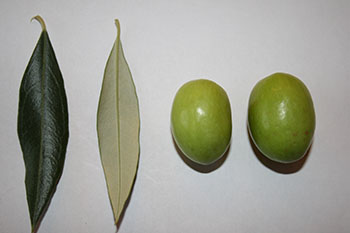Our Blog

Olive Varietals: What is in a Name?
"What's in a name? That which we call a rose by any other name would smell as sweet". William Shakespeare's famous line uttered by Juliette may be true of roses, but not quite as true with olive varietals.
Many Olive Varietals make olive oils taste different
The many different olive varietals, or cultivars, offer very different characteristics as both olive oil and table olives. Many think of olives as being either green or black, when in fact green olives are simply the young unripe fruits and all cultivars, as they mature, will "turn" into a speckled mauve and eventually black, or some shade of brown or purple, depending on the variety.
And how many olive varieties there are! While hundreds of different varietals exist in the species Olea Europaea, the exact number is not clear because cataloging has been insufficient due to subjective, incomplete, and the limited scope of studies. Research in genotypes continue and efforts the create germ plasma banks are underway (1). Despite the synonyms and homonyms that exist within cultivars, the distinct characteristics of the various varietals are unmistakable.
EVOO and Wine
Think of it like wine; the California wine industry taught the consumer to identify wines by the grape varietals used. One learns the characteristics of a Merlot, a Chardonnay etc. Olive oil functions in the same way. When we talk about red wine we can associate over 500 different sensorial traits; with olive oil there are 383. The different olive varietals are going to be the primary component in determining an olive oil's sensory profile. Other factors, such as terroir (the complete effect of the local environment), have a part, but let's focus on the varietal characteristics.
The Olive Tap's extra virgin olive oil varietals
![]() Here at The Olive Tap we have just received this year’s Sevillano and Ascolano olive oils. Sevillano, who derives its name from the province of Sevilla in Spain, has many synonyms: Gordal, Bella di Spagna, Spanish Queen, and more.
Here at The Olive Tap we have just received this year’s Sevillano and Ascolano olive oils. Sevillano, who derives its name from the province of Sevilla in Spain, has many synonyms: Gordal, Bella di Spagna, Spanish Queen, and more.
Although the varietal arrived in California in 1885, it became widely planted north of Sacramento, particularly in Corning, after 1910 when the shift in the California industry was made from oil to pickling (2). However a second shift, a so-called olive oil renaissance, took place at the turn of the 21st century and we now enjoy Sevillano as a subtle and refreshing extra virgin olive oil. The oil is fresh and herbaceous with crisp notes of green apple and delicate banana. It is a smooth oil with a slightly pungent finish. It is ideal for fish and seafood, delicate vegetables such as zucchini and summer squash and it is the secret ingredient in my flaky pie crust.
Ascolano
Ascolano is one of the five main commercial olive varietals that dominated in California throughout the 20th century. Despite the lack of evidence, some California producers promote the Ascolano olive as being a Tuscan varietal. Ascolano was in fact brought to California from Italy in 1885 as a standard Italian pickling olive. It was also known as Asiolani or White Olive of

Ascoli, (2) which links it to the varitietal Ascolana Tenera found in the province of Ascoli Piceno, in the southern part of the Marche region on the central Adriatic coast of Italy.
The Ascolana Tenera are stuffed, breaded, and fried to create the DOP recognized dish Olive Ascolane del Piceno. The Californian Ascolano was traditionally used as ripe canning olives until the industry shift from pickling to oil took place and this traditionally preserved olive turned into the most complex and surprising olive oils to come out of the New World.
This is a particular favorite of mine; its notes of fresh herbs, notably oregano and cat mint, with its incredible fruity peach and apricot nuances make this one of the most interesting oils being produced in California. Its versatility between savory and sweet dishes is remarkable. It adds depth to grated carrots and the like, its grassy notes highlight meat dishes, and paired with our Fresh Peach Balsamic make the most delightful vinaigrette. It is also the perfect oil for creating olive oil sundaes.
Olive Oil Sundae Recipe (Also Online via Link Below):
-Vanilla bean ice cream or gelato
-The Olive Tap Ascolano 100% Extra Virgin Olive Oil
-The Olive Tap Vanilla Sea Salt or Fleur de Sel
Into a generous scoop of the ice cream or gelato, insert holes with a chopstick or straw. Drizzle the The Olive Tap Ascolano EVOO generously over top and paying attention to allow the EVOO to fill the holes (this is so the olive oil is incorporated throughout the sundae and not just on top). Finish with a generous sprinkling of gourmet salt to taste.
View or Print Recipe On-line
Sources :
1) World Catalogue of Olive Varities, International Olive Council
2) Hartmann, HT and Papapioannuo, P, "Olive Varities in California" California Agricultural Experiment Station, 1951 olivecenter.ucdavis.edu/research/publications



